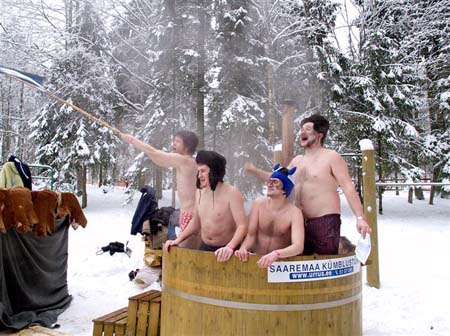 I have only been to Saaremaa once in my life. I was warned by my wife that I was entering a special zone within Estonia, where all the people lack a sense of humor. That is, Saarlased were allegedly principled to the point that principles came before all other things: eating, laughing, sleeping: if it was against their principles, then it wasn't for the Saarlased.
I have only been to Saaremaa once in my life. I was warned by my wife that I was entering a special zone within Estonia, where all the people lack a sense of humor. That is, Saarlased were allegedly principled to the point that principles came before all other things: eating, laughing, sleeping: if it was against their principles, then it wasn't for the Saarlased."So you are in Italian?" Epp's friend asked.
"Well, actually I am an American," I said.
"But your name is Italian," she pressed on.
"Well, both of my grandfathers were Italians."
Even this is not true. It's more complicated than that. Both of my grandfathers were born in America, but were the children of Italian immigrants. So my maternal grandfather didn't learn to speak English until he was seven years old or so. What do you consider such a person? In America you'd call him "first generation."
"You don't look like an American. You look Portuguese."
I informed him that I wasn't Portuguese but had Italian roots.
"Ah, Italian," he answered. "There is an Italian from Sicily coming here tomorrow to visit," he said.
But Arvo also asked me an unusual question: is there anything you don't like about Estonia. I was afraid of insulting his country, but I had an answer on the tip of my tongue. I explained to him how as wonderful as Estonia was, the folk music, particularly the songs about sailors, were driving me a little crazy. "Ah," he replied sympathetically. "I can see how that might get annoying."
Minding your 'Õ's and 'Ö's
One reason I felt good on Saaremaa was that many people had told me I had a Saare accent. That is, I found it impossible to make the Estonian 'Õ' sound, which is hard to phonetically represent in English. It's sort of a very tight-sounding combination of 'e', 'o', and 'u'. Instead I said words with more of an 'Ö', which is supposedly how Saarlased say them. So if anyone ever wondered about my strange Estonian accent, I could just tell them that I was from Saareemaa.
Before we went to bed after eating the prawns, I was sent out for a late night snack. I walked along the water towards the castle, and stopped in a shop that was still open. Epp had requested a certain kind of open-faced sandwich, but I was hungry too. I looked at the signs, and decided I would have the one with the salted ham on it, the one with the Italian-sounding name: forelli sai. I ordered perhaps six of these forelli sandwiches and headed back, passing a campsite where tourists were out sitting in lounge chairs and drinking beer.
As their words drifted into my ears, I determined that they were not speaking Estonian, nor Russian, nor German. That was Italian, alright. These were Italian tourists. And once again I was reminded that Estonia is indeed part of Europe, and in summer time, the European tourists flow into Estonia like any other natural part of the European Union.
When I got back to our room at the old sailor's guest house, I opened the bag to discover that what I mistakenly thought was some sort of prosciutto was really smoked fish, a food that I am not too fond of. I was scolded for buying so many forelli sai, but Epp ate them all in the end.
You see, Epp doesn't mind sitting in front of the TV, holding a smoked fish by its tail and consuming the animal like corn-on-the-cob. If we visited Greenland, I am sure she would have no problem downing seal blubber if it was handed to her. For me though, I might have to hold my breath before leaning in to kiss her after she has feasted on whatever creature from the bowels of the sea.
The next day on the way out of town we stopped in a cafe for some coffee and met up with a friend of Epp's who now lives on Saaremaa. Out of the corner of my eye I spied the Sicilian, on his way to meet Arvo at his guesthouse, and maybe, if he was lucky, to dig up some worms and go out fishing this very evening.
The Sicilian did not look like me though. He was about a quarter of my size and smoking a cigarette. "That's right," I thought to myself. "Most Italians are short!" The Sicilian was immersed in writing a postcard, perhaps to his home village of Corleone, about the exotic land he was visiting where people listened to accordion music ad nauseum and drank bowls, not cups of coffee.
I decided that I of all people should not randomly break the spell of Saaremaa for some Italic backslapping. So I slipped out the door with my wife, and left our Sicilian to continue along his merry way. I hope he enjoyed his stay in Kuressaare as much as I did.

















